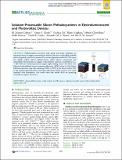Files in this item
Solution-processable silicon phthalocyanines in electroluminescent and photovoltaic devices
Item metadata
| dc.contributor.author | Zysman-Colman, Eli | |
| dc.contributor.author | Ghosh, Sanjay Sanatan | |
| dc.contributor.author | Xie, Guohua | |
| dc.contributor.author | Varghese, Shinto | |
| dc.contributor.author | Chowdhury, Mithun | |
| dc.contributor.author | Sharma, Nidhi | |
| dc.contributor.author | Cordes, David Bradford | |
| dc.contributor.author | Slawin, Alexandra Martha Zoya | |
| dc.contributor.author | Samuel, Ifor David William | |
| dc.date.accessioned | 2016-04-26T11:30:04Z | |
| dc.date.available | 2016-04-26T11:30:04Z | |
| dc.date.issued | 2016-04-13 | |
| dc.identifier | 241577673 | |
| dc.identifier | 84517938-679f-4838-b3a0-d4be370a2a0f | |
| dc.identifier | 84964837331 | |
| dc.identifier | 000374274900047 | |
| dc.identifier.citation | Zysman-Colman , E , Ghosh , S S , Xie , G , Varghese , S , Chowdhury , M , Sharma , N , Cordes , D B , Slawin , A M Z & Samuel , I D W 2016 , ' Solution-processable silicon phthalocyanines in electroluminescent and photovoltaic devices ' , ACS Applied Materials & Interfaces , vol. 8 , no. 14 , pp. 9247−9253 . https://doi.org/10.1021/acsami.5b12408 | en |
| dc.identifier.issn | 1944-8252 | |
| dc.identifier.other | ORCID: /0000-0002-5366-9168/work/28023984 | |
| dc.identifier.other | ORCID: /0000-0001-7183-6022/work/56639076 | |
| dc.identifier.other | ORCID: /0000-0002-9527-6418/work/56861606 | |
| dc.identifier.uri | https://hdl.handle.net/10023/8679 | |
| dc.description | E.Z.-C. acknowledges the University of St. Andrews for financial support. The authors thank the EPSRC UK National Mass Spectrometry Facility at Swansea University for analytical services. I.D.W.S. acknowledges support from the EPSRC (grant EP/J01771X), the European Research Council (grant 321305), and a Royal Society Wolfson Research Merit Award. | en |
| dc.description.abstract | Phthalocyanines and their main group and metal complexes are important classes of organic semiconductor materials, but are usually highly insoluble so frequently need to be processed by vacuum deposition in devices. We report two highly soluble silicon phthalocyanine (SiPc) diester compounds and demonstrate their potential as organic semiconductor materials. Near-infrared (λEL = 698-709 nm) solution-processed organic light- emitting diodes (OLEDs) were fabricated and exhibited external quantum efficiencies (EQEs) of up to 1.4%. Binary bulk heterojunction solar cells employing P3HT or PTB7 as the donor and the SiPc as the acceptor provided power conversion efficiencies (PCE) of up to 2.7% under simulated solar illumination. Our results show that soluble SiPcs are promising materials for organic electronics. | |
| dc.format.extent | 2917986 | |
| dc.language.iso | eng | |
| dc.relation.ispartof | ACS Applied Materials & Interfaces | en |
| dc.subject | Silicon phthalocyanines | en |
| dc.subject | Single crystals | en |
| dc.subject | Near-IR emission | en |
| dc.subject | Solution-processable organic light-emitting diodes | en |
| dc.subject | Organic solar cells | en |
| dc.subject | QD Chemistry | en |
| dc.subject | DAS | en |
| dc.subject | SDG 7 - Affordable and Clean Energy | en |
| dc.subject.lcc | QD | en |
| dc.title | Solution-processable silicon phthalocyanines in electroluminescent and photovoltaic devices | en |
| dc.type | Journal article | en |
| dc.contributor.sponsor | EPSRC | en |
| dc.contributor.sponsor | European Research Council | en |
| dc.contributor.institution | University of St Andrews. School of Chemistry | en |
| dc.contributor.institution | University of St Andrews. EaSTCHEM | en |
| dc.contributor.institution | University of St Andrews. School of Physics and Astronomy | en |
| dc.contributor.institution | University of St Andrews. Condensed Matter Physics | en |
| dc.identifier.doi | https://doi.org/10.1021/acsami.5b12408 | |
| dc.description.status | Peer reviewed | en |
| dc.identifier.url | http://pubs.acs.org/doi/suppl/10.1021/acsami.5b12408 | en |
| dc.identifier.grantnumber | EP/J01771X/1 | en |
| dc.identifier.grantnumber | en |
This item appears in the following Collection(s)
Items in the St Andrews Research Repository are protected by copyright, with all rights reserved, unless otherwise indicated.

